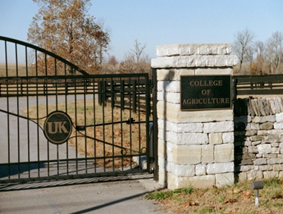Horse Unit
Overview of Research Facilities and Other Resources:

The Department of Animal and Food Sciences at the University of Kentucky operates a 100+ acre horse unit for teaching and research. The horse unit is located about 12 miles from the University of Kentucky campus on a portion of Maine Chance Farm in northern Fayette County. Maine Chance Farm was purchased by the University of Kentucky in the 1960’s and it is currently an important part of the Kentucky Agricultural Experiment Station. In addition to the horse unit operated by the Department of Animal and Food Sciences, many other agriculturally-related research programs are located at Maine Chance Farm and its neighboring farm, Spindletop.
The horse unit that is operated by the Department of Animal and Food Sciences includes several barns and more than 30 pastures/paddocks of various sizes. The farm routinely maintains about 100 horses, depending upon season of the year and teaching and research needs. The farm is operated by three full time staff and a number of student workers.
The Pirri Pavilion
A pavilion for on-farm teaching activities and other educational events was constructed in 2007 and recently remodeled following a generous gift from Dr. John Pirri, Jr. The horse handling area of the Pirri Pavilion is not climate controlled but provides a protected environment for classes involving hands-on horse activities in several undergraduate courses. In the spring the Pirri Pavilion is heavily used in EQM 105 which covers the principles of equine behavior as it relates to basic ground training of young horses. The classroom facility accommodates up to 75 students and includes “smart classroom” technology.
The nutrition barn
The nutrition barn contains 12 partially covered, individual pens. Each pen is 12' wide and 48' long and is equipped with an automatic waterer. The pens easily accommodate mature horses, growing horses and mare/foal pairs. The Nutrition Barn is used for feeding individual horses without imposing box stall confinement. It is well suited to studying the effects of dietary changes on growing horses, exercising horses and broodmares. The Nutrition Barn is adjacent to a 60' round pen and 6-horse euro-style exerciser.
Barn 3
Barn 3 was one of the original barns on Maine Chance Farm. Originally designed as a training barn for race horses, it is entirely enclosed and contains 18 box stalls in a back-to-back configuration with a tanbark walking area around the outside. Barn 3 includes a feed room, a small laboratory and a restraint stock. Six stalls in Barn 3 are equipped with automatic grain feeders and have rubber mat flooring. These stalls are useful for studies on digestibility, palatability and feeding behavior. In addition, this barn is used for teaching activities associated with classes in the Animal Science and Equine Science and Management.
Barn 5
This barn was recently remodeled and contains 10 large box stalls with rubber-mat floors that are excellent for a variety of research needs. The barn also includes two feed/equipment rooms, two sets of breeding stocks and a large laboratory/work area. This barn can be used to house mares and foals, yearlings or mature horses. It is an ideal location for nutrition studies evaluating the digestibility of different diets, and it is also useful for teaching and extension activities.
The Main Barn
The Main Barn area includes two separate structures. The bigger barn has 7 large foaling stalls, a breeding shed, a feed room and an office. The smaller barn has 4 box stalls. The Main Barn area is adjacent to 12 paddocks of various sizes. Several of the paddocks have run-in sheds. The Main Barn is used for foaling and breeding activities and also for research related to mares and foals.
Laboratory Facilities and Equipment
Most laboratory facilities at the research farm are used for initial sample handling. The majority of the sample analyses occur in laboratories in the Department of Animal and Food Sciences. The Department of Animal and Food Sciences has modern facilities and equipment for conducting a large variety of analytical procedures including: gas chromatography, HPLC, atomic absorption spectrophotometry, automated nitrogen analysis, automated ADF/NDF analysis, automated chemistry analysis (free fatty acids, triglycerides, creatine kinase, total protein, etc.), automated glucose/lactate analysis, in vitro incubations, etc.
Animal Resources
The core herd consists of mostly of thoroughbreds. The University of Kentucky does not operate a riding program, and all horses are maintained for research and for management classes in the Animal Science or Equine Science and Management Degree programs. Approximately 25 mares are bred each year in order to produce foals for various nutrition and management projects and in order to have horses for use in undergraduate and graduate courses. Foals are usually sold as yearlings through public auction; although some horses are occasionally available by private sale. The revenue from sale of horses is an important source of income for recurring costs on the farm (student labor, feed, health care, maintenance, etc). Questions about the availability of horses for purchase can be directed to Laurie Lawrence, Ph.D.; 859-257-7509.
